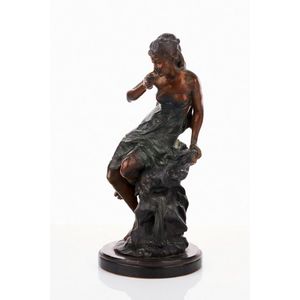Burr-walnut Louis XV Bureau Plat with Ormolu Decoration
You must be a subscriber, and be logged in to view price and dealer details.
Subscribe Now to view actual auction price for this item
When you subscribe, you have the option of setting the currency in which to display prices to $Au, $US, $NZ or Stg.
- Ormolu - Ormolu was popular with French craftsmen in the 18th and 19th century for ornamental fittings for furniture, clocks and other decorative items. True ormolu is gilt bronze, that is bronze that has been coated with gold using a mercury amalgam. Due to the health risks associated with using mercury, this method of creating ormolu was discontinued in France in the 1830s. A substitute was developed consisting of about 75% copper and 25% zinc, however it was inferior to the bronze version. It was often lacquered to prevent it tarnishing.
- Parquetry - Parquetry is inlay laid in geometric patterns, the contrast being achieved by the opposing angles of the grain and veneers. The herringbone pattern is the most commonly used in flooring, but this is almost never seen in furniture - the patterns used are more complex and unlike flooring, can include several different varieties of timber.
- Serpentine - Resembling a serpent, in the form of an elongated 'S'. A serpentine front is similar to a bow front, except that the curve is shallow at each end, swelling towards the middle. The term presumably derives from its similarity to a moving snake or serpent. Serpentine fronts are usually veneered, with the carcase either being cut and shaped from a solid piece of timber, or built in the 'brick' method.
This item has been included into following indexes:
Visually similar items

A French Louis XIV style marble and gilt wood. Console table, 20th century. Height 77 cm. Width 100.5 cm. Depth 44 cm

A French provincial fruitwood farmhouse table, late 19th early 20th century, the three plank top framed and on cabriole legs with shell motif carved apron, 224 cm wide, 96 cm deep, 76 cm high

A Staffordshire treacle glazed flask in the form of a mermaid, 19th century, 19 cm high

After Mathurin Moreau (French, 1822-1912), bronze sculpture, the spring, depicting a young maiden seated on a rock drinking water from a spring with the help of a shell, signed and numbered 12/100, on marble base, height 52 cm. Provenance: The Estate of D
